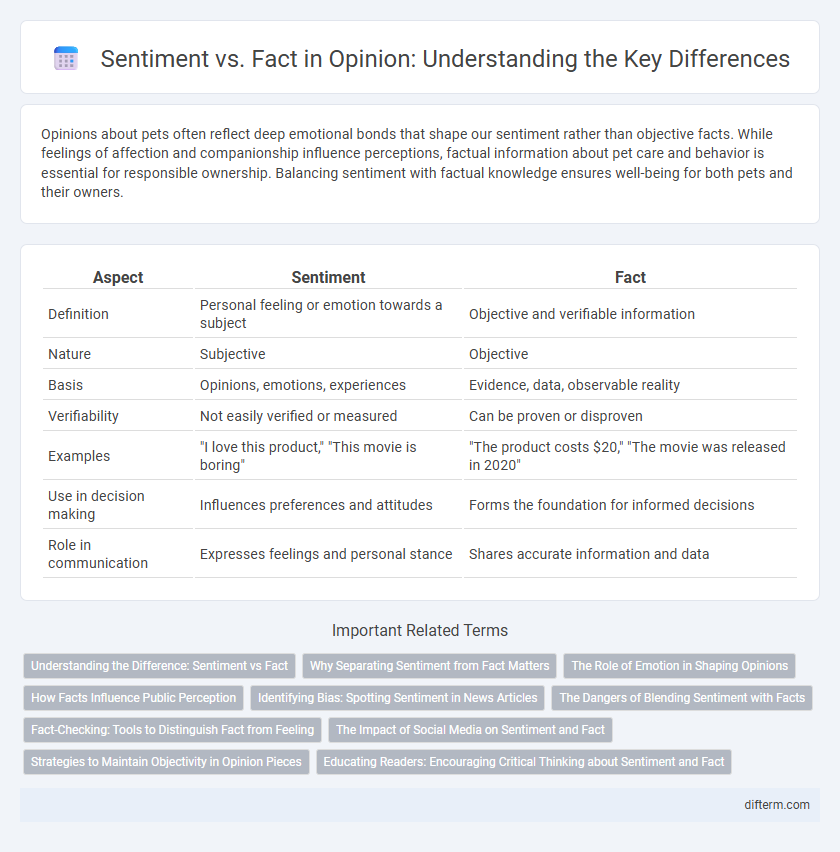Opinions about pets often reflect deep emotional bonds that shape our sentiment rather than objective facts. While feelings of affection and companionship influence perceptions, factual information about pet care and behavior is essential for responsible ownership. Balancing sentiment with factual knowledge ensures well-being for both pets and their owners.
Table of Comparison
| Aspect | Sentiment | Fact |
|---|---|---|
| Definition | Personal feeling or emotion towards a subject | Objective and verifiable information |
| Nature | Subjective | Objective |
| Basis | Opinions, emotions, experiences | Evidence, data, observable reality |
| Verifiability | Not easily verified or measured | Can be proven or disproven |
| Examples | "I love this product," "This movie is boring" | "The product costs $20," "The movie was released in 2020" |
| Use in decision making | Influences preferences and attitudes | Forms the foundation for informed decisions |
| Role in communication | Expresses feelings and personal stance | Shares accurate information and data |
Understanding the Difference: Sentiment vs Fact
Understanding the difference between sentiment and fact is essential for effective communication and decision-making. Sentiment reflects personal feelings, opinions, or emotions, often subjective and variable, whereas facts are objective, verifiable pieces of information grounded in reality. Distinguishing these elements helps avoid confusion and bias when analyzing data or forming judgments.
Why Separating Sentiment from Fact Matters
Separating sentiment from fact is crucial for ensuring objective analysis and informed decision-making. Sentiment reflects personal emotions and biases, which can distort the interpretation of factual information. Distinguishing the two helps maintain clarity, fosters trust, and supports critical thinking in discussions and evaluations.
The Role of Emotion in Shaping Opinions
Emotions significantly influence the formation and expression of opinions by adding personal meaning and intensity to perceptions. Sentiment shapes how facts are interpreted, often leading individuals to emphasize information that aligns with their emotional biases. Understanding the interplay between sentiment and fact is essential for recognizing the subjective nature of opinions and promoting more informed, balanced discussions.
How Facts Influence Public Perception
Facts shape public perception by providing objective evidence that anchors opinions in reality, reducing the impact of misinformation and emotional bias. The presence of verified data enhances trust and credibility, influencing how individuals interpret issues and make decisions. Accurate facts serve as a foundation for informed debate, guiding societal consensus and policy development.
Identifying Bias: Spotting Sentiment in News Articles
Identifying bias in news articles requires distinguishing between sentiment-driven language and objective facts, as sentiment often reflects the writer's attitudes or opinions rather than neutral information. Phrases with emotionally charged words or subjective assessments signal sentiment, potentially skewing readers' understanding of the events. Accurate news analysis demands emphasizing verifiable data while critically evaluating language that reveals implicit bias or partiality.
The Dangers of Blending Sentiment with Facts
Mixing sentiment with facts obscures objectivity and can distort the truth, leading to biased interpretations and misinformation. Facts provide verifiable evidence, while sentiment reflects personal feelings or opinions, and conflating the two undermines critical thinking. This blend increases the risk of emotional manipulation and erodes trust in reliable information sources.
Fact-Checking: Tools to Distinguish Fact from Feeling
Fact-checking tools utilize algorithms and extensive databases to verify claims and separate factual information from subjective sentiment. These platforms cross-reference statements with reliable sources, offering transparency and reducing misinformation spread driven by emotional bias. Employing fact-checking resources enhances critical thinking and supports informed decision-making in an era dominated by opinion-driven content.
The Impact of Social Media on Sentiment and Fact
Social media platforms significantly amplify emotional responses, often prioritizing sentiment over factual accuracy, which fuels misinformation and polarizes public opinion. Algorithms designed to increase user engagement promote sensational content, making it challenging for users to discern fact from opinion. This dynamic reshapes public discourse, with emotional appeals frequently overshadowing objective evidence.
Strategies to Maintain Objectivity in Opinion Pieces
Maintaining objectivity in opinion pieces requires distinguishing clearly between sentiment and fact, supported by verifiable data and credible sources to enhance trustworthiness. Employing balanced language and avoiding emotionally charged words can minimize bias, enabling readers to form independent judgments. Fact-checking and acknowledging opposing viewpoints further reinforce the integrity and fairness of the argument presented.
Educating Readers: Encouraging Critical Thinking about Sentiment and Fact
Encouraging readers to distinguish between sentiment and fact enhances critical thinking skills essential for informed decision-making. Teaching how to analyze emotional language versus evidence-based information fosters a deeper understanding of content credibility. Critical evaluation of sources and recognizing bias empowers readers to form balanced, objective opinions.
sentiment vs fact Infographic

 difterm.com
difterm.com